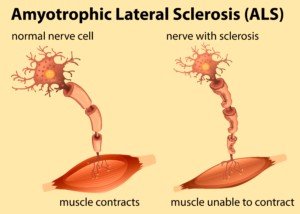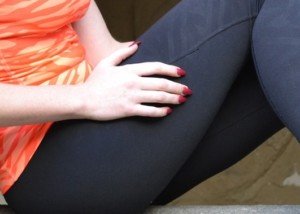Are you fearful of taking another bad fall after having surgery for a broken hip?
Here are 5 exercises designed for preventing older adults from another bad fall.
These exercises should begin only after the patient is sufficiently recovered from hip fracture surgery, and with the approval of their surgeon.
CHAIR RISE
Patient sits at the edge of soft chair or sofa, but not one that causes them to sink in it. The hips should never be lower than the knees in the seated position.
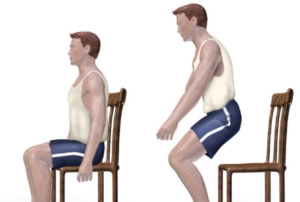
NOTE: This illutration depicts the exercise only. You should wear socks and supportive footwear, and the chair should be cushioned so that it’s comfortable sitting back down for repetitions. Feet should always be flat on the floor. BruceBlaus/CC
Stand up and do not allow the back of your legs to lean into the furniture. Sit back down with control (don’t lazily plop back down).
Rise up again, for a total of eight repetitions. This is not a speed drill. Each repeition is to be done thoughtfully with a focus on balance.
For older adults who feel off-kilter, or like they might lose balance on the way up or down, have someone standing at your side who can restabilize your body if you start to teeter. Eventually you’ll be able to do eight chair rises without any balance issues.
Progression: Hold a light medicine ball or dumbbell in both hands throughout; increase weight over time.
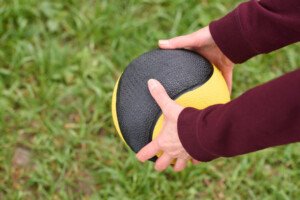
Light medicine ball
TRAY LIFT
Set a tray on a low bench; place a weight on it such as a thick dictionary, a few big cans of soup or a light dumbbell.
The exercise is to pick the tray up and set it down, for up to eight repetitions. However, this comes with some rules:
- Feet shoulder width apart
- Bend at the hips, keeping back straight
- Bend at the knees (one-quarter squat)
- Lean towards the tray — do NOT round or hunch your back
- Grab tray with straight arms, hands grasping either side of it, and straighten the body completely while holding the tray, keeping the back as erect as possible.
- Lower to set tray back in place — bending the knees, keeping the back upright.
Progression: Add more weight to the tray.
BALL CATCH
This excellent balance-improving exercise requires a partner.
You catch a child’s ball (about the size of a soccer ball) that’s tossed to you from about seven or eight feet away.
You don’t know where the ball is going to be tossed; right? left? high? low?
These varying, unpredictable locations in space will force your neuromuscular system fo make very fast decisions while moving your body to accommodate the approaching ball.
Depending on where the ball is thrown, you will be forced to side lunge or angle lunge to catch it.
If it’s a low toss you’ll have to squat a little to catch it.
If it’s a short toss you’ll need to lunge or flex your trunk forward a little to catch it.
NOTE: Whoever is tossing the ball should have the skill to control where to toss it.
You should catch ball with palms facing each other on either side of the ball rather than under the ball. Do not allow the ball to touch your chest.
All of these rules will sharpen your reflexes and balance — what a great way to help prevent a fall!
Progression: Use a heavier ball, beginning with a two-pound medicine ball.
TUG OF WAR
You will need a partner for this stellar fall prevention exercise.
Using workout resistance bands, the partner grabs the handles while you grab the bands (palms facing ceiling) about eight to 12 inches away.
Both of you are standing. You have your right foot ahead of the left, feet shoulder width or more apart, for stability.
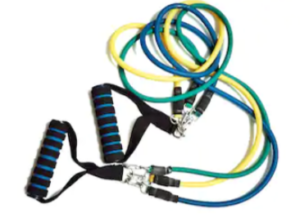
Resistance bands. I recommend the green or blue because the tension is more appropriate for the tug of war exercise. Shutterstock/Ken stocker
Your partner pulls while you oppose this. NOTE: Partner must be stronger than you and have solid control.
Your partner should force you to resist for a few seconds, rest, then repeat two more times; then repeat with your left foot now in front.
Progression: As you get stronger and improve balance, your partner should pull harder. If you’ve gotten really stable at this, you can narrow the space between your feet for more challenge.
CLOCK LUNGE
Take a lunge step forward with the right foot at 12 o’clock, then right foot at 3 (lateral or frontal plane lunge), then behind (6), then back to start (both feet together.
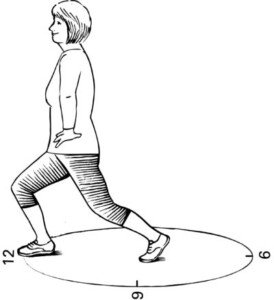
Repeat with left leg at 12, then at 3, then at 6, then both together. Both legs do five rounds.
If you feel uncomfortably off-balance with this, the forward and back lunges can be done in a hallway with you between the walls, hands ready to make contact with them should you teeter.
The side lunges can be done with a chair or table nearby for balance checks.
Progression: Hold a light weight with both hands.
Elderly Woman Breaks Hip from Fall; Postop Exercises Make Her Better than She Was Before the Fall
At age 88 my mother’s leg gave out (apparently from sciatica) and she fell, breaking her hip, requiring a total hip replacement.
In the several months leading up to this fall, I had noticed that her walking wasn’t stable.
The orthopedic surgeon told me that after the surgery, my mother would be on a walker for at least four weeks, and then the goal was to get her to a cane, and that she’d likely be on a cane for the rest of her life.
And it definitely looked that way in the three months after surgery. She refused to do any exercises, and the rehab facility she had stayed at for a week had been worthless.
Four months postop, her walking had improved in that it was no longer a limping, off-kilter gait.
But she was at risk for a second fall. I finally convinced her to let me give her twice-weekly, 30-minute exercise sessions for fall prevention.
In just three weeks, the improvement was quite noticeable. After three months my mother’s incentive dropped to just once a week sessions, but that still proved to be sufficient for a training effect.
In no way did my very elderly mother need a cane at this point, and I no longer worried about her falling.
 Lorra Garrick is a former personal trainer certified through the American Council on Exercise. At Bally Total Fitness she trained women and men of all ages for fat loss, muscle building, fitness and improved health.
Lorra Garrick is a former personal trainer certified through the American Council on Exercise. At Bally Total Fitness she trained women and men of all ages for fat loss, muscle building, fitness and improved health.
.



